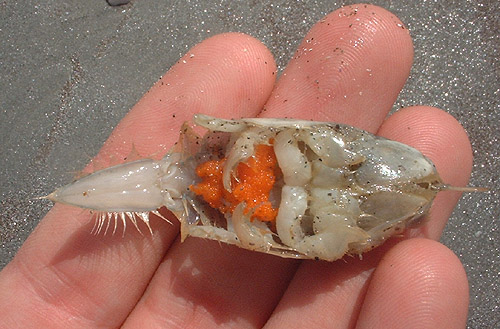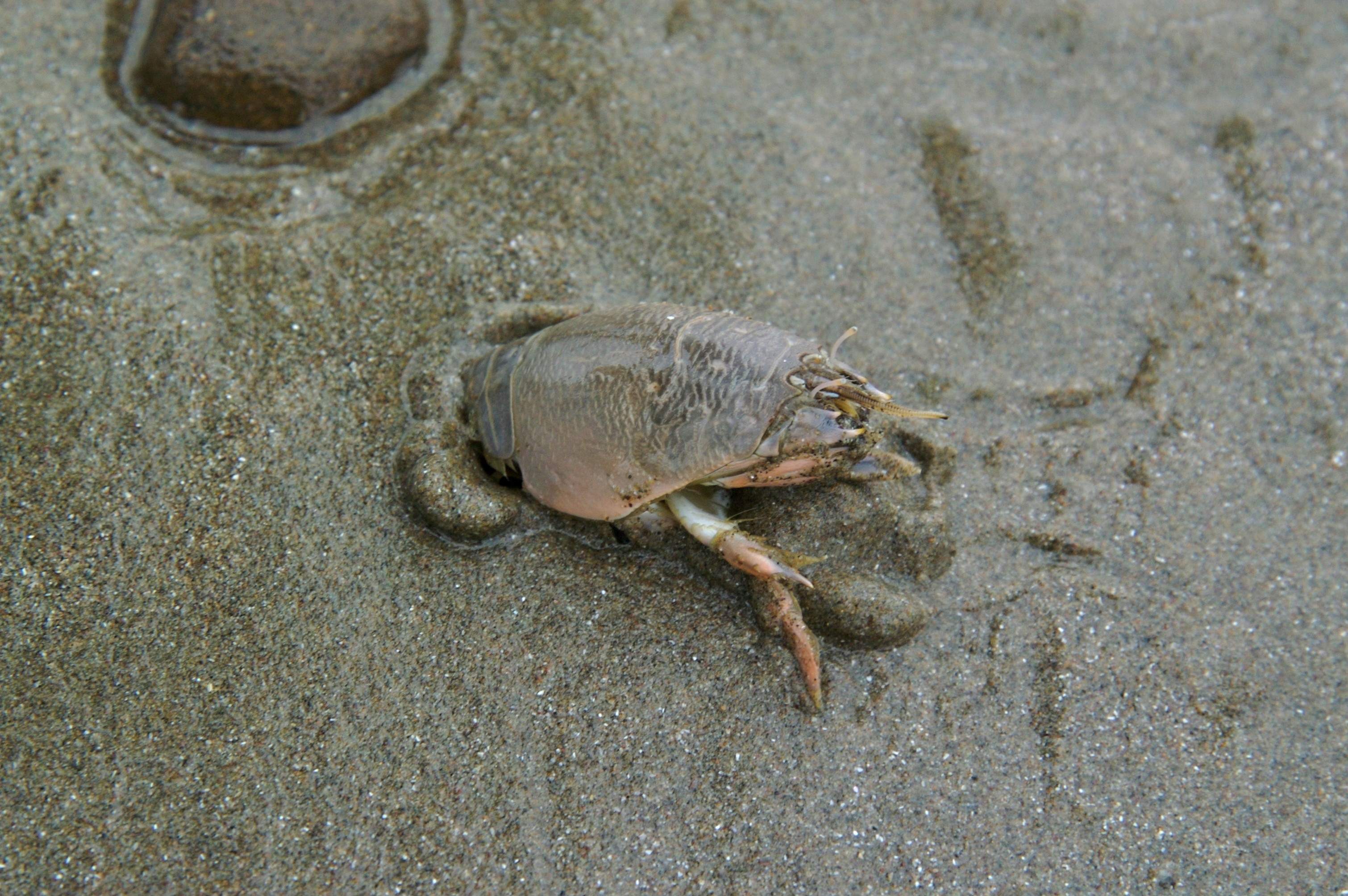|
Hippidae
Hippidae is a family of decapod crustaceans, currently known by the English name as either mole crab or sand crab, and by an earlier English name as sand bug. They are closely related to the family Albuneidae, with which they are usually joined in the superfamily Hippoidea. The family Hippidae comprises the three genera '' Emerita'', ''Hippa'' and '' Mastigochirus''. They burrow into sand, and are found throughout the world, except the Arctic The Arctic ( or ) is a polar region located at the northernmost part of Earth. The Arctic consists of the Arctic Ocean, adjacent seas, and parts of Canada (Yukon, Northwest Territories, Nunavut), Danish Realm (Greenland), Finland, Iceland, N ... and Antarctic. References Hippoidea Decapod families {{crab-stub ... [...More Info...] [...Related Items...] OR: [Wikipedia] [Google] [Baidu] |
Hippoidea
Hippoidea is a superfamily of decapod crustaceans known as sand crabs or mole crabs. Ecology Hippoids are adapted to burrowing into sandy beaches, a habit they share with raninid crabs, and the parallel evolution of the two groups is striking. In the family Hippidae, the body is almost ovoid, the first pereiopods have no claws, and the telson is long, none of which are seen in related groups. Unlike most other decapods, sand crabs cannot walk; instead, they use their legs to dig into the sand. Members of the family Hippidae beat their uropods to swim. Apart from the polar regions, hippoids can be found on beaches throughout the world. Larvae of one species have also been found in Antarctic waters, despite the lack of suitable sandy beaches in the Antarctic. Classification Alongside hermit crabs and allies (Paguroidea), squat lobsters and allies (Galatheoidea) and the hairy stone crab (''Lomis hirta'', Lomisoidea), Hippoidea is one of the four groups that make up the infraorde ... [...More Info...] [...Related Items...] OR: [Wikipedia] [Google] [Baidu] |
Emerita Analoga
''Emerita analoga'', the Pacific sand crab or Pacific mole crab, is a species of small, sand-burrowing decapod crustacean found living in the sand along the temperate western coasts of North and South America. It is found on exposed sandy beaches in the swash region of the intertidal zone. Description The Pacific sand crab is a small crustacean growing up to long and wide. The female is nearly twice as large as the male and can often be identified by the orange egg mass carried under the telson. The adult is sand-coloured and well camouflaged, and has no claws or spines. It has five pairs of legs and three pairs of pleopods. Sand crabs moult periodically, so their exoskeletons may be found washed up on the beach. The sand crab is well adapted to life in the sand, which presents an unstable substrate, and its shape is an elongated dome shape designed for fast burrowing. The eyes are on long stalks and the antennules are also elongated so as to project above the surface of the ... [...More Info...] [...Related Items...] OR: [Wikipedia] [Google] [Baidu] |
Hippa
''Hippa'' is a genus of decapod crustaceans in the family Hippidae, containing the following species: *''Hippa adactyla'' Fabricius, 1787 *''Hippa admirabilis'' Thallwitz, 1892 *''Hippa alcimede'' de Man, 1902 *''Hippa australis'' Hale, 1927 *''Hippa carcineutes'' Holthuis & Manning, 1970 *''Hippa celaeno'' de Man, 1896 *''Hippa granulatus'' Borradaile, 1904 *''Hippa hirtipes'' Dana, 1852 *''Hippa indica'' Haig, Murugan & Balakrishnan Nair, 1986 *''Hippa marmorata'' Hombron & Jacquinot, 1846 *''Hippa ovalis'' A. Milne-Edwards, 1862 *''Hippa picta'' Heller, 1861 *''Hippa strigillata'' Stimpson, 1860 *''Hippa testudinaria'' Herbst, 1791 *''Hippa truncatifrons ''Hippa'' is a genus of decapod crustaceans in the family Hippidae, containing the following species: *''Hippa adactyla'' Fabricius, 1787 *'' Hippa admirabilis'' Thallwitz, 1892 *'' Hippa alcimede'' de Man, 1902 *'' Hippa australis'' Hale, 19 ...'' Miers, 1878 It is closely related to the genus '' Emerita'', and spe ... [...More Info...] [...Related Items...] OR: [Wikipedia] [Google] [Baidu] |
Emerita (crustacean)
''Emerita'' is a small genus of decapod crustaceans, known as sand crabs, or mole crabs. These small animals burrow in the sand in the swash zone and use their antennae for filter feeding. Description ''Emerita'' has a barrel-shaped body. It has a tough exoskeleton and can hold its appendages close to the body, allowing it to roll in the tidal currents and waves. It has feathery antennae, which are used to filter plankton and detritus from the swash. Males are typically smaller than females, and in some species, such as '' Emerita rathbunae'', the minute males live attached to the legs of the female. Females are around in carapace length, depending on the species, while males vary from a similar size to females in '' E. austroafricana'', down to carapace length in ''E. rathbunae'' and '' E. talpoida''. Distribution The genus as a whole has a broad distribution in tropical and subtropical regions. Most individual species, however, are restricted to smaller areas, and their ... [...More Info...] [...Related Items...] OR: [Wikipedia] [Google] [Baidu] |
Pierre André Latreille
Pierre André Latreille (; 29 November 1762 – 6 February 1833) was a French zoologist, specialising in arthropods. Having trained as a Roman Catholic priest before the French Revolution, Latreille was imprisoned, and only regained his freedom after recognising a rare beetle species he found in the prison, ''Necrobia ruficollis''. He published his first important work in 1796 (), and was eventually employed by the . His foresighted work on arthropod systematics and taxonomy gained him respect and accolades, including being asked to write the volume on arthropods for George Cuvier's monumental work, , the only part not by Cuvier himself. Latreille was considered the foremost entomologist of his time, and was described by one of his pupils as "the prince of entomologists". Biography Early life Pierre André Latreille was born on 29 November 1762 in the town of Brive, then in the province of Limousin, as the illegitimate child of Jean Joseph Sahuguet d'Amarzit, général ... [...More Info...] [...Related Items...] OR: [Wikipedia] [Google] [Baidu] |
Family (biology)
Family ( la, familia, plural ') is one of the eight major hierarchical taxonomic ranks in Linnaean taxonomy. It is classified between order and genus. A family may be divided into subfamilies, which are intermediate ranks between the ranks of family and genus. The official family names are Latin in origin; however, popular names are often used: for example, walnut trees and hickory trees belong to the family Juglandaceae, but that family is commonly referred to as the "walnut family". What belongs to a family—or if a described family should be recognized at all—are proposed and determined by practicing taxonomists. There are no hard rules for describing or recognizing a family, but in plants, they can be characterized on the basis of both vegetative and reproductive features of plant species. Taxonomists often take different positions about descriptions, and there may be no broad consensus across the scientific community for some time. The publishing of new data and opini ... [...More Info...] [...Related Items...] OR: [Wikipedia] [Google] [Baidu] |
Decapoda
The Decapoda or decapods (literally "ten-footed") are an order of crustaceans within the class Malacostraca, including many familiar groups, such as crabs, lobsters, crayfish, shrimp and prawns. Most decapods are scavengers. The order is estimated to contain nearly 15,000 species in around 2,700 genera, with around 3,300 fossil species. Nearly half of these species are crabs, with the shrimp (about 3,000 species) and Anomura including hermit crabs, porcelain crabs, squat lobsters (about 2500 species) making up the bulk of the remainder. The earliest fossil decapod is the Devonian ''Palaeopalaemon''. Anatomy Decapods can have as many as 38 appendages, arranged in one pair per body segment. As the name Decapoda (from the Greek , ', "ten", and , '' -pod'', "foot") implies, ten of these appendages are considered legs. They are the pereiopods, found on the last five thoracic segments. In many decapods, one pair of these "legs" has enlarged pincers, called chelae, with the legs be ... [...More Info...] [...Related Items...] OR: [Wikipedia] [Google] [Baidu] |
Crustacean
Crustaceans (Crustacea, ) form a large, diverse arthropod taxon which includes such animals as decapods, seed shrimp, branchiopods, fish lice, krill, remipedes, isopods, barnacles, copepods, amphipods and mantis shrimp. The crustacean group can be treated as a subphylum under the clade Mandibulata. It is now well accepted that the hexapods emerged deep in the Crustacean group, with the completed group referred to as Pancrustacea. Some crustaceans (Remipedia, Cephalocarida, Branchiopoda) are more closely related to insects and the other hexapods than they are to certain other crustaceans. The 67,000 described species range in size from '' Stygotantulus stocki'' at , to the Japanese spider crab with a leg span of up to and a mass of . Like other arthropods, crustaceans have an exoskeleton, which they moult to grow. They are distinguished from other groups of arthropods, such as insects, myriapods and chelicerates, by the possession of biramous (two-parted) limbs, and by th ... [...More Info...] [...Related Items...] OR: [Wikipedia] [Google] [Baidu] |
Albuneidae
Albuneidae is a little-known family of specialized burrowing sand crabs. There are 50 extant species as well as nine fossil species that have been described. Fossil specimens have been described from the Cretaceous, Miocene The Miocene ( ) is the first epoch (geology), geological epoch of the Neogene Period and extends from about (Ma). The Miocene was named by Scottish geologist Charles Lyell; the name comes from the Greek words (', "less") and (', "new") and mea ... and Oligocene. References Further reading * Hippoidea Decapod families {{crab-stub ... [...More Info...] [...Related Items...] OR: [Wikipedia] [Google] [Baidu] |
CSIRO Publishing
CSIRO Publishing is an Australian-based science and technology publisher. It publishes books, journals and magazines across a range of scientific disciplines, including agriculture, chemistry, plant and animal sciences, natural history and environmental management. It also produces interactive learning modules for primary school students and provides writing workshops for researchers. CSIRO Publishing operates within the Commonwealth Scientific and Industrial Research Organisation (CSIRO). It was established as a stand-alone business unit in 1995. Books CSIRO Publishing publishes books in a number of categories, including: * Animals: behaviour; birds; domesticated; ecology and management; field guides; fish; genetics and evolution; health and welfare; invasive; invertebrates; mammals and marsupials; reproduction and physiology; reptiles and amphibians; and wildlife. * Built Environment: architecture; building; codes and standards; engineering; landscape architecture; and pla ... [...More Info...] [...Related Items...] OR: [Wikipedia] [Google] [Baidu] |
Genera
Genus ( plural genera ) is a taxonomic rank used in the biological classification of living and fossil organisms as well as viruses. In the hierarchy of biological classification, genus comes above species and below family. In binomial nomenclature, the genus name forms the first part of the binomial species name for each species within the genus. :E.g. ''Panthera leo'' (lion) and ''Panthera onca'' (jaguar) are two species within the genus '' Panthera''. ''Panthera'' is a genus within the family Felidae. The composition of a genus is determined by taxonomists. The standards for genus classification are not strictly codified, so different authorities often produce different classifications for genera. There are some general practices used, however, including the idea that a newly defined genus should fulfill these three criteria to be descriptively useful: # monophyly – all descendants of an ancestral taxon are grouped together (i.e. phylogenetic analysis should clearly demons ... [...More Info...] [...Related Items...] OR: [Wikipedia] [Google] [Baidu] |




